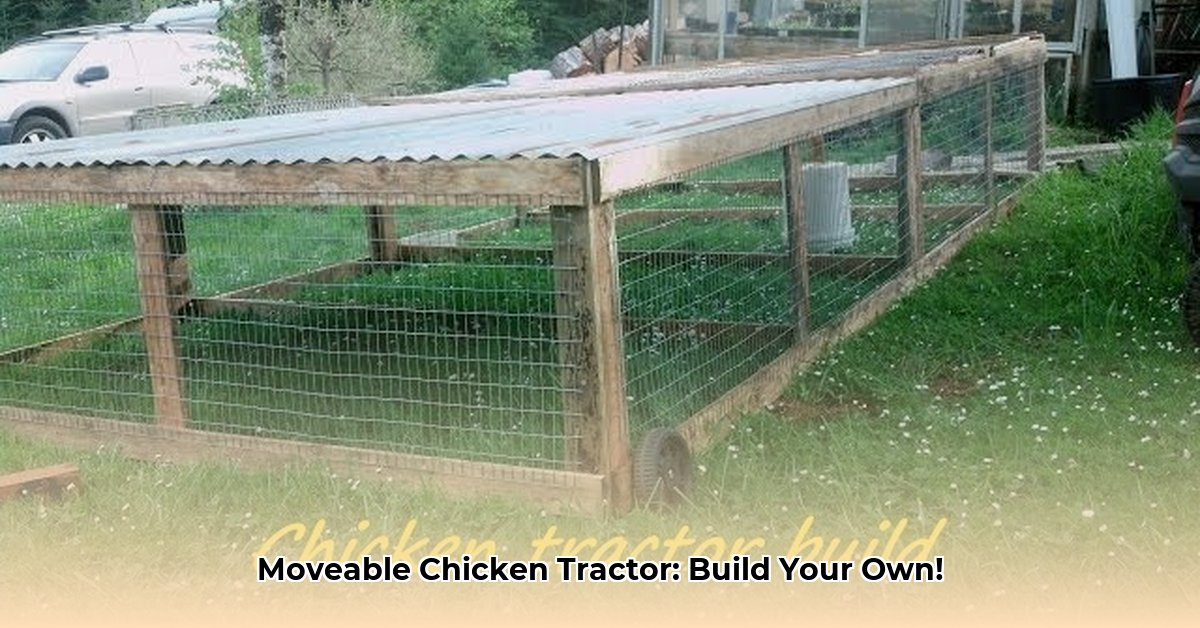
Want fresh, farm-fresh eggs and happy, healthy chickens? A moveable chicken tractor—essentially a portable coop—is the answer! This guide walks you through building your own or buying a pre-fabricated model, like the popular Egg Cart'n. We'll cover everything from design and construction to placement, maintenance, and troubleshooting, ensuring you're set up for success. For another great option, check out this cattle panel design.
DIY vs. Buy: Choosing Your Chicken Tractor Adventure
Building your own moveable chicken tractor is a rewarding project, offering customization and significant cost savings. However, it requires time, basic construction skills, and planning. A pre-built option like the Egg Cart'n provides convenience and often superior durability, but comes at a higher initial price. Which path suits you best? Let's explore!
The DIY Moveable Chicken Tractor: A Step-by-Step Guide
1. Selecting Your Blueprint: Start by finding a chicken tractor plan that matches your skill level and desired features. Numerous free and paid plans are available online, ranging in complexity. Beginners should opt for simpler designs.
2. Gathering Your Materials: Create a comprehensive list. Materials will vary based on your chosen plan, but generally include:
- Lumber: (Pressure-treated pine or cedar is recommended for rot resistance). Quantity depends on your design and the size of your flock.
- Hardware Cloth: (Sturdy wire mesh to keep out predators). Choose a gauge appropriate for your local wildlife.
- Hinges: (Heavy-duty hinges are crucial for frequent use). Consider galvanized steel for rust resistance.
- Wheels: (Select wheels suitable for your terrain). Larger wheels are better for uneven ground.
- Fasteners: (Galvanized or stainless steel screws and nails are ideal). Quality fasteners are key for a durable coop.
- Roofing Material: (To protect your chickens from the elements). Consider asphalt shingles or metal roofing.
3. Construction: Safety first! Wear safety glasses and gloves throughout the construction process. Follow your chosen plan meticulously, taking your time to ensure accurate measurements and secure fastenings. Having a helper is extremely beneficial, especially when lifting heavier components.
4. Predator-Proofing: This is non-negotiable. Secure all openings with hardware cloth, eliminating any potential entry points for predators. Consider burying the bottom of the wire mesh a few inches underground for added protection against digging predators.
5. Cleaning Considerations: Design your coop with cleaning in mind. Removable floors or pull-out trays significantly ease the cleaning process, minimizing unpleasant tasks in the future.
Commercial Chicken Tractors: A Review of the Egg Cart'n and Alternatives
Pre-fabricated chicken tractors, like the Egg Cart'n, provide a quicker and often more durable alternative to DIY.
Pros:
- Convenience: Ready-to-assemble (or pre-assembled) designs save significant time and effort.
- Durability: Commercial models often utilize robust materials and construction methods, resulting in longer life spans.
- Features: Many come with built-in features, such as improved ventilation and easy cleaning trays.
Cons:
- Cost: Commercial options have a significantly higher upfront cost than DIY projects.
- Customization Limitations: You're limited to the manufacturer's design and features.
Do you currently own a chicken tractor? Don't hesitate to share your experiences, which could prove invaluable to first-time owners! (This rhetorical question encourages reader interaction).
Choosing the Right Option: DIY vs. Commercial
The best option depends on your budget, skills, and time commitment. Consider the following:
| Feature | DIY | Commercial |
|---|---|---|
| Cost | Lower | Higher |
| Time Commitment | High (several hours or more) | Moderate (a few hours of assembly) |
| Customization | High | Limited |
| Durability | Variable (dependent on construction) | Typically Higher |
Siting, Stocking, and Maintaining Your Chicken Tractor
Successful chicken keeping extends beyond construction.
- Placement: Choose a sunny, well-drained location. Rotate the tractor regularly to prevent overgrazing and parasite buildup. (This fact improves pasture health and reduces parasite loads).
- Breed Considerations: Select a coop size appropriate for your chosen chicken breeds. Larger breeds require more space. Allow at least 4 square feet per standard-size chicken; larger breeds will require more.
- Regular Cleaning: Clean the coop weekly (or more frequently, depending on flock size) to prevent disease. A pressure washer simplifies this task significantly.
Troubleshooting: Common Issues and Solutions
Even with careful planning, problems may arise. Common issues include damaged netting, broken parts, and pest infestations. Regular inspections and proactive maintenance will prevent most problems; however, unexpected repairs might still be necessary.
Key Takeaways: Maximize Your Chicken Tractor Success
- Mobile coops offer superior pasture management and hygiene.
- DIY requires skill, while commercial options offer convenience.
- Coop size must match breed size and flock numbers—overcrowding is detrimental.
- Strong predator protection is essential; assess local predators.
- Regular maintenance is crucial for the coop's longevity and your chickens' health.
This comprehensive guide empowers you to build or purchase the perfect moveable chicken tractor, ensuring your chickens thrive and you enjoy fresh, delicious eggs!